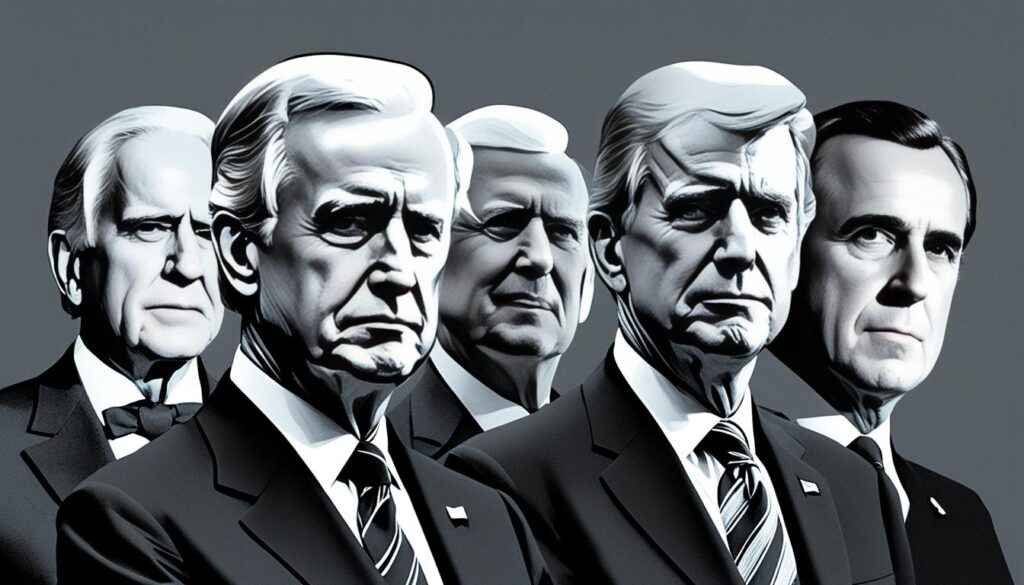The vice president plays a crucial role in American government. They serve as second-in-command and can assume the presidency if needed. However, four U.S. presidents served their entire term without a vice president.
Before 1967, the vice presidency could only be filled during post-election inaugurations. If a vice president died, resigned, or became president, the office remained vacant. James Madison, the fourth president, was the first to experience this situation.
The presidents who served without vice presidents were John Tyler, Millard Fillmore, Andrew Johnson, and Chester Arthur. They all became president after their predecessors died. This highlighted the need for a better presidential succession plan.
Key Takeaways:
- Four U.S. presidents served their entire term without a vice president: John Tyler, Millard Fillmore, Andrew Johnson, and Chester Arthur.
- Before the 25th Amendment in 1967, the vice-presidential position could only be filled during the next post-election inauguration.
- James Madison was the first president to spend part of his term without a vice president.
- The absence of a vice president underscored the importance of establishing a clear line of presidential succession in American history.
James Madison’s Struggle with Choosing Vice Presidents
James Madison, the fourth U.S. president, faced challenges in selecting vice presidents during his two terms. He struggled to find suitable running mates and ensure stable presidential succession. Madison’s experience highlighted the importance of a reliable vice president.
For his first term, Madison chose George Clinton as vice president. Sadly, Clinton died in office on April 20, 1812. This left the vice presidency vacant until 1813, showing the need for continuity in governance.
Madison selected Elbridge Gerry for his second term. Unfortunately, Gerry also died in office on November 23, 1814. Once again, Madison was left without a vice president until 1817.
These events emphasized the need for a robust presidential succession system. They also highlighted the critical role of vice presidents in executive branch stability. Madison’s experiences served as a reminder of the importance of capable vice presidents.
The untimely deaths of Clinton and Gerry left Madison without vital support for long periods. This underscored the need for clear succession plans to ensure smooth government functioning during crises or vacancies. Madison’s presidency revealed the crucial role of vice presidents in presidential succession and effective governance.
Presidents Without Vice Presidents
Several U.S. presidents have served without a vice president. These vacancies occurred due to death or resignation of the sitting VP. The length of vacancy varied from partial to full presidential terms.
John Tyler became president after William Henry Harrison’s death in 1841. He finished his term without a VP. This set a precedent for future similar situations.
Millard Fillmore, Andrew Johnson, and Chester Arthur also served without VPs. They took office after their predecessors died.

Other presidents faced periods without a vice president too. These included Andrew Jackson, Franklin Pierce, and Ulysses S. Grant. Grover Cleveland, William McKinley, and Theodore Roosevelt also experienced this.
William H. Taft, Calvin Coolidge, and Harry S. Truman had no VP for a time. Lyndon B. Johnson, Richard Nixon, and Gerald Ford joined this list.
The 25th Amendment, adopted in 1967, addressed vice presidential vacancies. It clarified presidential succession and provided a way to appoint a new VP. This amendment has been used twice since its ratification.
The Importance of the Vice President in Modern American Politics
The vice president’s role in American politics has greatly changed over time. Today, they are vital members of the executive branch. Many bring extensive public service experience to the office.
The 25th Amendment, adopted in 1967, was a game-changer for the vice presidency. It created a clear process for appointing a new vice president if needed. This ensures a stable line of presidential succession.
The amendment has been used several times since its ratification. This highlights its importance in maintaining leadership continuity.
For the 2024 election, the choice of running mate will likely impact public opinion. Vice presidential picks often balance the ticket and appeal to key groups. They may also bring expertise in specific policy areas.
The vice president now has more influence on policy decisions. They serve as a key advisor to the president. This makes the selection process more crucial than ever in modern politics.

Leave a Reply